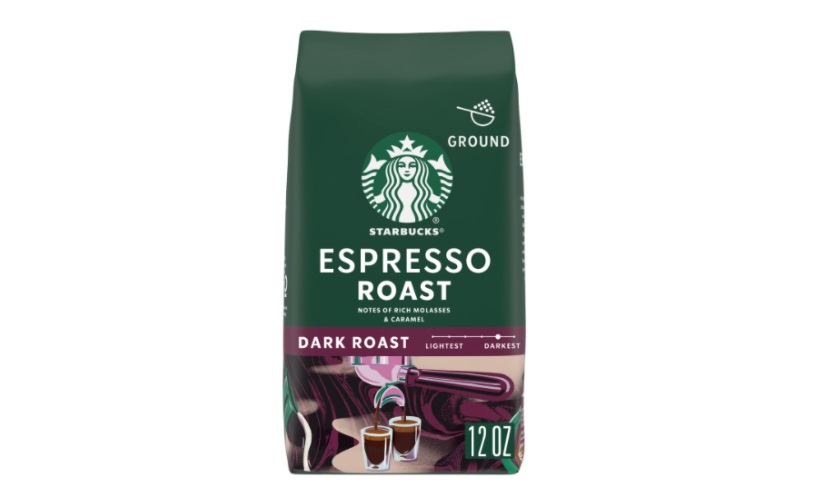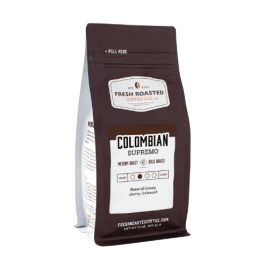
Espresso roast ground coffee is known for its dark, rich profile, specifically crafted to enhance the espresso brewing experience. This type of coffee is roasted longer than regular coffee, allowing oils to rise to the surface of the beans. This process not only darkens the beans but also intensifies their flavor, making it perfect for the concentrated burst of coffee that espresso provides.
The roast level of espresso ground coffee plays a critical role in defining its flavor profile and how efficiently its compounds are extracted during brewing. A darker roast typically yields a bolder, more robust flavor with reduced acidity, which is ideal for espresso’s quick extraction process. This intense flavor profile is what makes espresso the heart of many favorite coffee drinks like lattes and cappuccinos.
Key Takeaways
- Rich Flavor: Espresso roast coffee is prized for its intense, full-bodied flavor. This makes it the ideal choice for espresso, which is meant to be a concentrated coffee experience.
- Grind Size Matters: The fine grind size of espresso coffee is crucial. It ensures that the water can extract the coffee flavors efficiently in the short time that it passes through the coffee during the espresso brewing process.
- Bean Type Variability: The type of coffee bean, whether Arabica or Robusta, affects the flavor and caffeine content of the espresso. Arabica beans tend to be sweeter and softer, while Robusta beans offer a stronger, sometimes harsher, flavor with more caffeine.
- Storage for Freshness: Proper storage is essential for maintaining the freshness and flavor of espresso roast coffee. Keeping the coffee in a cool, dark place in an airtight container helps preserve its quality and taste.
Types and Characteristics of Espresso Roast
Espresso roast coffee can vary significantly depending on the roast level: light, medium, or dark. Light roasts are the mildest, with a light brown color and no oil on the surface of the beans. They retain most of the original coffee bean flavors, which can be overshadowed by the flavors that come from the roasting process itself. Medium roasts are darker, richer, and more balanced in flavor, acidity, and aroma. They are often preferred for espresso as they highlight the unique characteristics of the coffee without overpowering bitterness.
Dark roasts are where espresso really starts to get its characteristic boldness. These beans are roasted until they start to ooze oils, giving them a shiny, dark appearance. This roast level produces a coffee that’s less acidic but richer in burnt or smoky flavors, which can stand up to the intense brewing process of espresso without losing its depth.
The roasting process not only impacts the color and texture of the beans but also affects the coffee’s flavor and aroma profiles. As the beans are roasted darker, they develop rich caramelized sugars and decrease in acidity, resulting in a bold, robust flavor that makes for a powerful espresso shot.
Best Practices for Brewing Espresso Roast Coffee
Selecting the right grind size and brewing technique is crucial for making a great espresso. The grind should be very fine, almost powdery, which is essential for the short, intense extraction process of espresso making. If the grind is too coarse, the water will flow through too quickly, resulting in a weak espresso. If it’s too fine, it might clog the espresso machine and lead to over-extraction, making the espresso taste bitter.
For brewing, maintaining the right water temperature (between 195°F and 205°F) and pressure (about 9 bars) is key to extracting the full flavor without bitterness. Tamping the grounds evenly before brewing is also important to ensure water passes through the coffee uniformly, extracting flavors consistently.
Achieving the perfect extraction involves balancing grind size, temperature, and pressure to extract the best flavors within 25-30 seconds of brewing time. If your espresso comes out too fast, consider a finer grind; if it’s too slow, a coarser grind might be needed. Adjusting these elements can lead to a rich, creamy, and flavorful espresso that’s robust and invigorating.
Popular Brands and Blends
When it comes to espresso roast coffee, brands like Illy and Starbucks stand out as market leaders. Illy is renowned for its smooth, rich espresso blends that use 100% Arabica beans. This brand focuses on a single, finely tuned blend of espresso roast that is favored for its consistent flavor and luxurious feel. Illy’s approach to espresso is about balancing the beans’ natural flavors with the art of espresso brewing, making it a favorite among traditional espresso lovers.
Starbucks, on the other hand, offers a variety of espresso roasts, catering to a broader audience. Their Espresso Roast is famously rich and caramel-like, developed from a blend of beans from Latin America and Asia-Pacific. Starbucks’ method involves roasting beans at a higher temperature for a longer period, which emphasizes a deeper, more pronounced flavor profile. This makes it popular among those who enjoy a bolder, more robust espresso.
What makes these brands particularly popular is not just their distinctive flavor profiles but also their global availability and consistent quality. Both brands have mastered the balance between wide-scale distribution and maintaining high-quality standards, ensuring that each cup of espresso reflects their signature styles.
The Science Behind Espresso Roast Coffee
The science of roasting espresso coffee is complex, involving careful manipulation of temperature and time to achieve the desired flavor profile and acidity. During roasting, the beans undergo significant chemical changes. As the beans are exposed to heat, they begin to caramelize, releasing sugars and oils which contribute to the coffee’s body and taste.
The degree of roasting impacts the acidity; darker roasts generally have less acidity but more bitterness due to the longer roasting times breaking down more of the acidic compounds. The roast level also affects the aroma, with darker roasts typically having a stronger, more pungent smell.
Additionally, the origin and processing of the beans play crucial roles in the final taste of the coffee. Beans from different regions come with unique flavor notes, such as floral, fruity, or nutty. The processing method—whether washed, semi-washed, or natural—affects the bean’s moisture and oil content, which can alter how the beans react to heat during roasting.
FAQs
How does espresso roast differ from regular coffee roast?
Espresso roast is typically darker than regular coffee roast, which means it has been roasted for a longer time at higher temperatures. This process produces a richer, more intense flavor suited to the quick extraction methods used in espresso machines. Regular coffee roasts vary more in range and can be lighter, retaining more of the original bean’s flavor nuances.
What is the best way to store espresso roast coffee?
To keep espresso roast coffee fresh, store it in an airtight container away from direct sunlight, heat, and moisture. It’s best kept in a cool, dark place like a pantry. For longer storage, some may opt to freeze the coffee, but it’s crucial to ensure it’s in a completely airtight container to avoid moisture contamination.
Can espresso roast be used in regular coffee makers?
Yes, espresso roast can be used in regular coffee makers, but the grind size should be adjusted to match the brewing method. For drip coffee makers, a medium grind is suitable, whereas espresso machines require a finer grind. The robust flavor of espresso roast can enhance a regular cup of coffee, giving it a bolder taste.
Final Thoughts
Espresso’s enduring appeal lies in its powerful sensory profile, capable of delivering a concentrated coffee experience that’s both aromatic and flavorful. Its place in coffee culture is secure, celebrated for its versatility in crafting everything from a simple morning shot to the base of more complex coffee beverages. Whether enjoyed in a bustling café setting or from the comfort of one’s home espresso machine, espresso roast coffee continues to captivate and energize coffee enthusiasts around the world.









